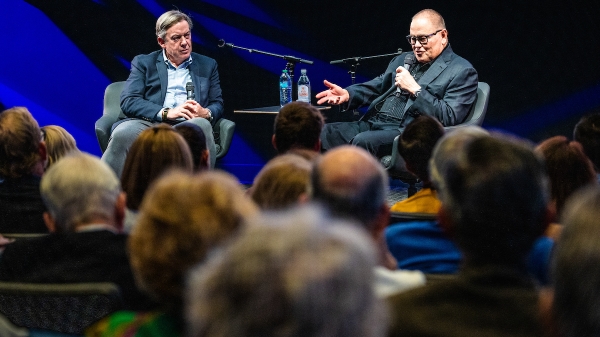How many of you shop on Facebook? Maybe you’ve done it once or twice, but regularly? You’re probably more likely to go to a website like eBay or J.Crew to shop, not to a social media platform.
But a recent report by a company that specializes in information technology services predicted social commerce worldwide will grow into a $1.2 trillion business by 2025. It cited one day in October 2021 when two of China's top live streamers sold $3 billion worth of goods — roughly three times Amazon's average daily sales.
The report estimated that in the U.S., social commerce will more than double, reaching $99 billion by 2025, with the largest gains in clothing, consumer electronics and home decor.
We talked to Pei-yu Sharon Chen about how realistic this prediction is. Should companies step up their social media game? Chen is the chair and professor in the Department of Information Systems and co-director of the Actionable Analytics Lab in the W. P. Carey School of Business at Arizona State University.
She talked about how this is largely a geographic phenomenon, why it’s not likely to take root here, how it works and what it takes to hit those numbers.
Editor's note: Answers have been edited for length and clarity.
Question: Is this a realistic prediction? I’ve only bought products two or three times on Facebook. It’s not what I think of when I think of going online to buy something.
Answer: There are definitely huge differences here and in Asian markets. Not just in China; it's actually through all the Asian markets, like in Taiwan, Japan, Korea. They are seeing very similar patterns. So this kind of social shopping and commerce has taken off really quickly. And the growth is amazing. I looked at the number in the report. I'm actually quite optimistic with that estimate. Although I don't see that the U.S. would see that kind of growth here in the very near future because of the fundamental difference in the way people interact, as welll as the way we shop, as well as the infrastructure.
(In Asia) the infrastructure makes it possible because again, it's a much more dense, populated area. ... So if you think about logistics, right, you can easily fulfill and then ship this dinner to this different household, but in the U.S., it would be more difficult because the distance is larger.
Q: Is this more predictive when viewed through the lens of a demographic (younger people) or place (most of the numbers in the story come from China)?
A: This is also more so for young generations — the digital native, right? So they have very low attention spans. ... We tend to go shopping when we really need it; we quickly up pick up stuff. What social shopping does is ... first, they trigger demand, and then you can fulfill your demand. ... In social shopping, these are all content creators. They have built trust. They attract an audience in different ways. ... This is embedded marketing, right? So when (content creators) talk about certain products or certain things they do, we say, "Huh, OK. Maybe I'll give that a try.”
Q: Besides the fact that people live so densely in Asia that a two-hour delivery is possible, how is social commerce so big in Asia?
A: Traditional shopping is all advertising. Only certain sellers can afford this expensive marketing. If a celebrity signed a contract with a company, then you cannot sell another kind of product. But here, in a short video, you are able to actually touch upon several different products and then trigger interest. So it actually opens opportunity for smaller businesses. It could be from a small shop: "Hey, I now have this little dessert that I can sell." They don't make a huge capacity because there's only so much that they can make. But as they are able to fulfill that continuously, that's what they want. So that's why in Asia, a lot of these content creators now partner with a lot of small businesses to do marketing like this for longer runs. So one week, we purchased from this store. This next week, we purchased from this, and then maybe one month later, we rotate back because that's when they are able to service the previous month's demand. So you can see that now it opens a huge opportunity.
Q: Is their presence online more elaborate? You go on Facebook now in the U.S. and a clothing company will show you a picture of a shirt or a jacket. That's it. It's not really any different than the newspaper. So what's happening in Asia? Is there more elaborate engagement with consumers?
A: Yes, a lot more engaging. For example, for a Facebook page in the United States, you see fans from all over the country. So in terms of how to fulfill customers from all over the country, it's definitely more difficult. But in Asia, they can do this same-day, or even two-hour shipping. That's still difficult in the states.
(Fans) also interact in real time with things. ... If something triggers their interest they can immediately type and then connect with other fans. It makes it very interesting. Fans are interested in participating. Usually a content creator may have either a nightly show or maybe weekly, then people are looking forward to it.
Top image courtesy iStock
More Business and entrepreneurship

Scrappy, adaptive, inventive: A fireside chat with GoDaddy’s Bob Parsons
GoDaddy founder, Vietnam War Marine veteran and New York Times bestselling author Bob Parsons joined Arizona State University President Michael Crow for a fireside chat at ASU’s MIX Center in Mesa on…

Why consumers are flying high this holiday season
A few years ago, the airline industry was in serious trouble.The COVID-19 pandemic crippled travel, and U.S. airlines received $54 billion in taxpayer bailouts, according to the U.S. Department of…

Being kind with in-kind donations
Charities and nonprofits with retail stores must walk a fine line when accepting in-kind donations from the public.If they turn away items they can’t use, they could appear ungrateful. But if they…
